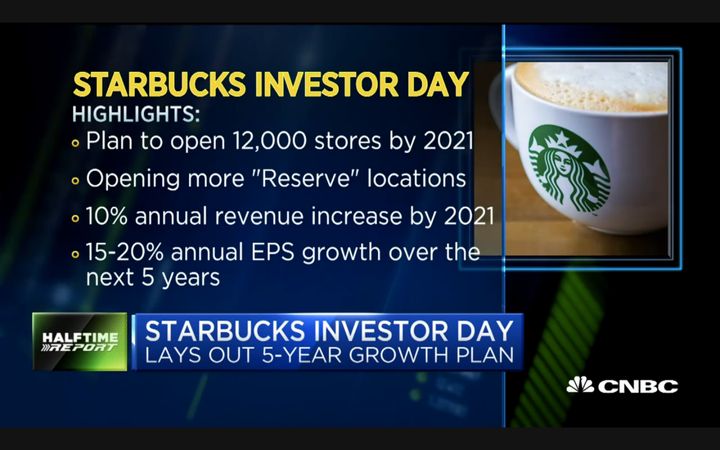
Starbucks’ Dec 7th investor day announcements featured bold growth aspirations.
CNBC Halftime Report screenshot
50% growth might sound like a lot, but this is one of those cases where context actually matters.
If you’re a tech startup, growing at 50% probably won’t get you much of a second glance from investors. You’re in a world where founders are forecasting revenue growth of around 120 percent for their first year, dropping down to 83 percent for the second year, and a mere 60 percent for the third year. This makes sense, since you’re doing something new, looking for market interest and adoption, and you’re arguably going from zero - so 120 percent growth for something that the market actually wants should be pretty easy to achieve.
In other words, your 50% growth aspiration is rather unremarkable.
Now, what if you were already in 25,000 locations around the world, with a brand that holds a coveted spot on Forbes’ World’s Most Valuable Brands list (I’ll admit - I thought it would be higher than it is). You already touch 80-90 million customers a week (!!!) and now you state that you want to grow by 50%. That means you’ll add 12,000 new locations while diversifying into a differentiated upmarket experience. You’re going to do all this (while focusing on an enhanced digital/AI experience) in pursuit of profit growth of 15-20% per year while fulfilling your mission: to inspire and nurture the human spirit – one person, one cup, and one neighborhood at a time. And you’re going to transition your leadership at the same time.
If you’re Starbucks, you’re going to need more than execution to get it right. When you’re running a global enterprise hundreds of thousands of employees impacting that many customers, and you ramp up to target aggressive growth with new product launches and expansion into new markets, things are bound to go wrong.
The leadership and board of Starbucks likely concluded that they didn’t have many options but to declare a path of aggressive growth and expansion. Their stock is down almost 2% over the past year while the Dow is up almost 14% and the S&P is up almost 12%. When you’re a market leader and your stock isn’t out-performing the market (let alone tracking with the market), investors become anxious. So a bold plan is needed. Now the challenge shifts to execution. At speed. And at scale.
Starbucks opening new locations (over 2,000 a year if the expansion is linear) would represent an eight percent increase in the number of stores. Eight percent might not sound that impressive, but try opening 2,000 stores every year. It’s an astonishing undertaking. To make sure that they get this done on time, and across their global operating footprint, Kevin Johnson and the team at Starbucks need to get a few things right. But there is one thing that is more important than all of the others.
Of course, securing the most efficient and optimal (environmentally friendly) supply chain is important. So too is hiring - and training - the thousands of people (or partners, in Starbucks-speak) who will deliver the great experience across all of these new and existing stores. There are no doubt many project plans that already exist and that will be created to manage the thousands of decisions that go into executing this sort of growth. And that diligent planning is important.
But without focus and urgency, I’m convinced that Starbucks will falter. This is, arguably, one of the riskiest periods for Starbucks’. If they fail to deliver on their investor day commitments they will be punished by the market. If they don’t deliver consistently for their customers, their brand will be slaughtered by unforgiving consumers. If they become a soul-less execution-oriented corporate machine, their employees partners will become disillusioned and they’ll attract people who care more about execution than creating that great Starbucks experience.
Instead, what should be top of mind across Starbucks right now is how to simplify the message (so that everyone knows how they connect to this growth plan) and how to make it so incredibly inspiring and aspirational that the very best people want to be at Starbucks, and want to make the future a reality. Every people manager should understand deeply just how they and their team can contribute to making the 2021 plan a reality. A barista serving a beverage is enhancing the brand and the customer experience, making sure that every customer is 100% satisfied. A procurement manager sourcing coffee beans from Kenya is reinforcing the sustainability operation and securing the supply chain, looking for new opportunities to make it even better. An internal auditor in Seattle is making sure that controls are enabling the most efficient operation possible, while looking for opportunities to control risk and make processes even better. A construction manager in China is charged with opening stores at break-neck speed, maintaining the standards and quality that Starbucks demands while looking for ways to make things better and/or faster and/or cheaper.
The point is that every single player in the Starbucks ecosystem has the potential to improve how Starbucks is already thinking of delivering the 2021 plan. And if I were Kevin Johnson, it would be a huge relief to me knowing that hundreds of thousands of partners are looking to make our venti 2021 plans a reality - rather than relying solely on a cadre of senior executives and project managers.